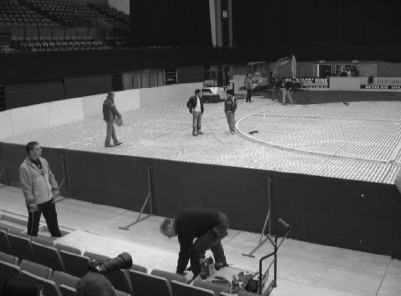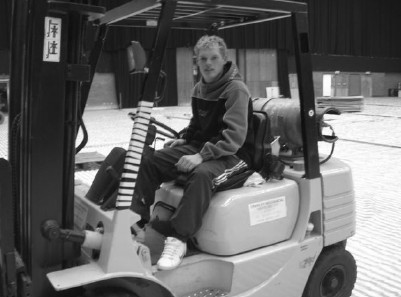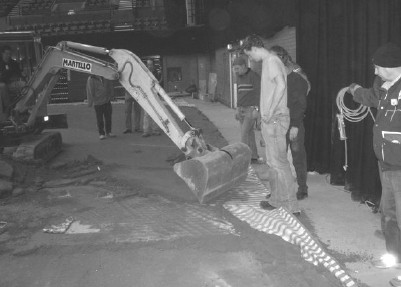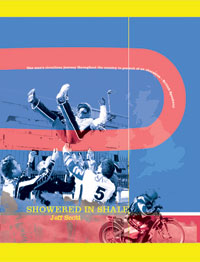
| ||||||||
| ||||||||
|
|
Behind the Scenes at the 2005 Brighton Bonanza
The Brighton Centre on the seafront has been a venue for an incredible variety of events including the indoor speedway meeting known as the Brighton Bonanza. Though the fabric of the building has begun to show signs of its age, the event promoted by Martin Dugard and Jon Cook has become a key occurrence on the winter calendar for speedway fans. In fact after the close of the official season and the onset of cold turkey, this is the first chance that the fans will have to get their regular fix- although in the cut-down indoor version of the sport which, to echo Spock on Star Trek, is speedway, but not as we know it. To get the full experience of the event Jon Cook has kindly allowed me to spend time behind the scenes to watch the Brighton Centre transform itself. Last night it was the venue for a concert by 1980s Norwegian pop rockers 'a-ha'; throughout the day it will be an indoor speedway track; and tomorrow it will host the Stereophonics in concert. Not only has Jon allowed me to watch the event from behind the scenes, he's also "volunteered" my help to work on whatever odd jobs need doing throughout the whole manic 24 hours that he estimates it will take to transform the venue, stage the event and return it, once more, to its almost pristine state. With approximately 120 tons of dusty and dirty shale due to arrive there's a strong sense of purpose among the mini-army of helpers, the majority of them familiar faces from the meetings each week at Arlington, industriously working away. I get to work on various duties necessary to help erect the wooden safety fence. The event has run here every year since 1997 and, as I look around, it certainly appears that everyone knows their tasks and their place in the complicated set up and installation process. There's a posse of workmen who assemble the special fencing to protect the bank of seats that will house the spectators who'll be closest to the track and start line. Wooden boards are fitted in front of this large bank of red seats. A gantry is used to install the start gate mechanism as the electricians run their cables throughout the perimeter of what will become the track surface when the shale is eventually transported from the depot via the loading bay and onto the surface of the auditorium floor, to then be rollered into an almost pristine state to provide a competitive racing surface. All this is a considerable feat in itself. A new faux white marble floor in the Brighton Centre is the major factor that affects the layout and installation of this year's event. The rampant anxiety of the Centre's management and the sensible concern of Jon and Martin about the possible damage that the sheer weight of shale could wreak on this surface has resulted in the floor being covered with thick plastic sheeting rather than the wooden boards that have previously been used to cover it in recent years. On this plastic protective layer, the shape of the track has already been clearly marked out and surrounded with two complex oval shaped rings of wooden boards and slats. These inner and outer rings delimit what will become the tracks perimeter and what will form the centre green. The need for careful plans and measurement to the nearest inch in such a confined space is paramount and even with hardly any equipment installed, I can't help but marvel at how they will manage to use this severely restricted space. To be at work at this time of the morning necessarily marks you as both a volunteer and an enthusiast. Like the sport itself, it's a predominantly male environment and only Kath from the Eastbourne Speedway Office (who lifts many heavy objects with greater strength, dexterity and skill than myself throughout) and Julie Martin the photographer represent the fairer sex. What is immediately noticeable is the energy, zeal, commitment and application that everyone brings to their various tasks. Many people are keen to inform me that they have worked on the Bonanza "every year" since it began. The idea sprang from a bet made during a local television studio appearance by Martin Dugard and the rest, they say, is history.
The first lorry load of 30 tons of damp shale has already arrived in the loading bay and is being unloaded. One current version of what people imagine a speedway rider's life is like is that you turn up to the track, hop on your bike to ride a few races at great speed with bravado before you retire to the bar. Apart from this (and ignoring the groupies), it's just a question of banking some sponsors' cheques, sleeping late before you clean and maintain your bike for a bit, then sleep again in the van or plane on the way to your next meeting. The true shape of the reality of any ambitious young British speedway rider's world was already being staged in miniature in the loading bay where last year's Individual Champion, Edward Kennett, was very hard at work in the back of the shale lorry with a shovel. He'd already done a few hours work back at the depot before I spotted him just after 1.30 a.m. as he worked very industriously along with Lance his lorry driver colleague from Eagles sponsor 'Robins of Herstmonceux'. Edward's task was to break up the shale so that the earthmover can drive into the back of the lorry and shovel out scoops of shale. Each individual load of shale is then dumped and spread out inside the designated track shape marked out on the plastic-covered floor. It was a task that was repeated endlessly throughout the morning, continuously, relentlessly, and without a break except for when there was a slight delay for the next lorry load of shale to arrive at the loading bay. Today promises to be a long day's work for Edward since he'll work from before midnight, then ride in the Pairs and Individual event at the meeting before he again helps with some of the breaking down and packing away afterwards. With some understatement he acknowledges it's going to be a "long day" though he'll still be back at work as normal on Monday, "I'll probably go in the afternoon though, as I work for these anyway and they know what I've got to do and don't mind". Unloading the damp shale is an all-round family and team effort, which also features Gary Robins who drives the digger and his brother Norman who works on the track itself with another large machine. In such a confined space, they both exhibit very impressive control of their machinery. You'd expect this equipment to be used in a rough fashion that befits the heavy, often brutal, work involved with the shale, but they both use their tools with a confidence, delicacy and movement that constitutes its own industrial form of ballet. My impression, as a first-time visitor, was that everyone appeared to intuitively just know what to do, the order of what gets done when and exactly what tasks were expected of them individually. As I lean on the loose boards of the safety fence with another experienced old hand familiar with the staging of these events, Roy Prodger, and watch the feverish activity going on in front of us, he explains that to fit together all the various components is a bit like completing a giant jigsaw puzzle. But in this case, you have the added complication of considerable time pressure as well as the need to wait for some tasks to be completed so that others begin. Apart from Martin Dugard who works and rushes about the place like a man possessed, there were many other very familiar faces from Arlington race meetings. These included Roy Prodger, Malcolm Cole, Alan Rolfe, Kath and various other members of the track staff (like John Strudwick and Neil Hollebon). The complexity and detail of all the things that you must consider or remain vigilant about as the events organisers is staggering. There's car-parking logistics in the light of the complications presented by the huge queues of Christmas shoppers that later will throng to the area along with an armada of riders' bikes and vans. If that and the need to ensure that the track is set up in time wasn't enough already, there is also the staging of some additional Academy League races during the Bonanza to consider and Jon now realises that to fit all the bikes, riders, mechanics and parents into the narrow confines of the loading bay area "will be a nightmare!" Another noticeable aspect of the preparations is the care and attention that the track itself receives throughout the morning. Obviously it's the essential component (!) for the meeting and the installation of such a surface indoors is the unique selling point of the Bonanza. The careful fastidiousness with which the rough shale is slowly packed down to create the smooth racing surface leads me to think everyone is a frustrated prize gardener lovingly tending their favourite roses. By all accounts the track will be thicker when it's finally laid and the popular consensus is that it won't cut up this year. Norman Robins, who spreads the heaped piles of shale across the plastic sheets, is a true artisan with his equipment as he carefully redistributes the dark brown gravel of the shale in roughly even quantities throughout the auditorium with dexterity and precision. Once the shale is placed in position, it's packed down with the mini-steamroller. The colour of the shale changes as it's compressed from a very dark brown to a lighter and more caramel hue. I am amazed how the sheer volume of tons of shale is transformed into a racing surface, no more than a few inches thick, when it's finally laid to everyone's satisfaction. But before you arrive at that stage there's a tremendous amount of attention lavished on the surface not only by large earth-moving machinery but also the ultimate in low-tech equipment - small red watering cans with which Jon Cook finesses the track. It's an implement of extremely modest proportions, tiny in fact when you contrast it to the enormity of the track or the weight of the shale that's required to construct the surface. The lure of the simplicity of the watering can technology exerts considerable magnetism throughout the morning and later in the day since everyone appears to briefly want to use them. To have the strength to lift the heavy blue and yellow wooden safety boards around the place is also a prerequisite. Edward Kennett, who has switched to drive the forklift truck with a pallet of the boards balanced carefully on the forks, takes the boards round the circuit to their position, while he waits for another lorry to wend its way through the thick early morning fog from Hurstpierpoint to Brighton seafront. Much of the fixtures and fittings, the speedway furniture as it were, has been brought along from Arlington. As you unpack the huge number of stanchions you can't help but admire the handiwork of whoever packed them away the last time they were used during the season. It requires an eye for detail and an intuitive awareness of patterns that would serve you well at the entrance examination to be admitted to MENSA. Inside the centre, it appears that every eventuality has been thought of and that everything is almost always to hand. As dawn breaks I go for breakfast as the track is nearly finished and when I return the loading bay area of the Brighton Centre now teems with people, vans and bikes. While there's still the odd task going on, the transformation of the arena is almost completed and the auditorium has been further tidied up and kitted out in the final splendour of its match-racing look. The track looks perfect and in pristine condition. The referee's panel is in the centre green along with all the various flags. The speakers are in position and so is a small table where the trophies stand to await the winners from today's meeting. Many of the track staff stand and lean on the fence rather contentedly as they admire their handiwork. In fact there's an understandable air of satisfaction among all the helpers, which contrasts with the feverish activity in the pits. In the loading bay area behind us, the various ages of the riders span 33 years from the suspiciously and luxuriantly brown-haired American Bobby Schwartz, who at 49 is the oldest Bonanza competitor to the youngest participant at 16, the highly fancied Lewis Bridger. In contrast to the ambient air temperature, the atmosphere in the pits is warm and friendly among the competing riders. The final races of the evening result in a Grand Final line up of Dugard, Kennett, Schwartz and the surprise rider of the evening, Kerr. To further highlight the fun nature of the event, Martin Dugard joins the rider parade to the start line for choice of gates in the final wearing a Superman outfit over his kevlars. In this version, Superman doesn't look so svelte as in cartoons or on film, but the crowd really appreciates it. Edward Kennett caps off a superb Bonanza when he wins the six-lap final race from Superman/Dugard, and it enables him to win his second trophy of the day. It's a fantastic achievement for one so young but especially so in the light of the fact that he had already worked at the Centre since midnight. Apart from Martin Dugard, all his other rivals were tucked up in bed getting some well deserved rest in preparation for the demands of the racing ahead. After the presentations, all that now remains is for us to pack up and go home! For the crowd this is simple, although many of them remain in the auditorium for the last possible glimpse of the riders. The riders, mechanics and parents pack away the bikes with their customary zeal, no doubt helped in their desire to leave by the cold wind that blows through the loading bay. Martin and Edward swiftly change from their kevlars back into their work clothes to join the crowd of helpers that remain to pack the show away. Throughout the day everyone reassured me that everything gets packed away much faster than the early morning construction of the Bonanza. The meeting has finished on time and given that it's only 8.45 p.m., we have an absolute eternity until our agreed curfew time of 3 a.m. Around this time, the Centre staff will re-purpose the grandstand seats and their layout, construct the stage and so complete preparations to enable the early morning arrival of the equipment for the next night's Stereophonics concert. Everyone on the breakdown team reckons that, if things proceed as usual, then we should be packed up and away within a couple of hours or, by midnight at the latest, if there's any unexpected delay. While the various items of speedway furniture brought over from Arlington are quickly dismantled, it's soon apparent that the decision to place the shale on a protective layer of plastic to safeguard the faux marble effect floor will cause us a major problem and huge delays. With huge but typical understatement Jon Cook explains to me that, "it hasn't gone to plan with the shale".
Basically, the shale can't just be quickly scooped up off the floor by the digger arm, as usual, because the plastic immediately rips. When wooden boards form the base of the track, as they had every other year, the shale surface could be easily scooped into a dumper truck and then efficiently shifted; despite the great control and extreme delicacy with which the scoop is operated, the result is an unacceptable mix of shale and plastic. While this complex problem is pondered, everything else continues to be dismantled and packed away. This includes the safety fencing, the wooden floor, the electrics, the start gate along with all the other weird and wonderful paraphernalia required to construct a seamlessly organised speedway meeting. The only other small delay is caused by the monkey-puzzle conundrum of how to stack the safety fence support barriers into a neat and stable pile on pallets. As Martin Dugard is THE expert when it comes to carefully packing away practically every object of Arlington based equipment, we have to wait until he solves our conundrum. Soon only the shale track remains stubbornly and very obviously still in position. They say that success has many fathers, but failure is usually a solitary activity. In the case of the Bonanza track, there's quite a gaggle of interested and capable men who all offer their ideas as to the best solution to the horrendous shale removal problem. In the next hour or so, no matter how complicated or silly, all these suggestions are tried, but without any hint of success. Without the furniture the track appears to grow in size and the problem of its removal appears hopelessly intractable. I'm not sure who exactly identified the solution to the problem but whoever it was deserves a lifetime's free admission to the event. Inevitably the solution is extremely painstaking since it involves a laborious and repetitive procedure, plus extreme skill with the forklift and copious amounts of patience. In a nutshell, the forklift forks have to drive wooden planks into the narrow gap between the shale surface and the plastic floor covering. Each plank has to be carefully placed in position by hand. The effect is to break the compacted shale into huge but more moveable lumps and so - plank by plank, yard by yard - we slowly separate the compacted shale from the plastic. These heavy lumps of shale then have to be shovelled by hand into piles sufficiently large to enable them to be picked up by the scoop. Every single shovel load of the 120 tons of the shale track have to be picked up in this painstaking and laborious manner. To say that this is backbreaking repetitive work would be a huge understatement, never mind it's an extremely dusty and messy business. It would choke you if you did it outside in a breeze, but it's quite a different kettle of fish altogether when you do it indoors. Everyone's humour (well, mine and a few other people's) isn't helped by the fact that it has already been an extremely long day after our early morning start. When Jon agreed that I could get some real and memorable behind the scenes experience of the Bonanza, I didn't for one minute imagine that this would be it! By 11pm the hard core of helpers massively dwindles and, by this point, it disillusionally seems that we have hardly lifted and shifted any of the track surface. At the present rate of progress, with only a small portion of the widened corner removed, it appears that we might work until daybreak tomorrow. The tedium, brutality and glacial pace of the work involve a real concerted team effort. It takes mental and physical determination to get it even half done, never mind completed. It certainly teaches me respect for anyone who has to do this type of manual work regularly and respect for all those here who had volunteered to do this work year in and year out in the full knowledge of what it really entailed. We work extremely tenaciously and industriously. After all, we have a shared interest to accomplish the task as quickly and competently as possible by the contractual 3 a.m. deadline. The auditorium itself fills with a choking cloud of dust raised by hacking the compacted surface of the track into many pieces. All this activity produces a light film of dark dust that coated the faux white marble effect flooring and every other surface in the Centre. The staff hired by the Brighton Centre, who arrive en masse near midnight, all wear safety masks throughout our work. They are employed every night to clear the seating of litter before they do a variety of other cleaning tasks. By 1 a.m. this team have cleaned up lots of dust, while we just continue to create more! When it is all over at almost dead on 3 a.m., I feel a real sense of elation and pride at our team accomplishment - as many of the others say they do every year - and everyone permits themselves some sort of smile at the end. For many of the people who remain working at this hour, however, there is still much more work to do in Herstmonceux to unload the shale; and it will be many hours before they find the comfort of their beds. The roll call of workers on our chain gang in the final dusty hours were: Mick Robins (supervisor, enthusiast and one of the lads); Gary Robins (brilliant operator of the yellow loading shovel); Norman Robins (brilliant driver of the mini-digger); Lance Wyman (hard grafter) and his son Jamie (who worked well but managed to be more morose than me); Eric Dugard's son Matt (with a sunny disposition and extreme skill on the fork lift); Dougie Ballard (hard grafter); Edward Kennett (hard grafter allowed to go home early but only after he'd won every trophy on offer at the event); Ashley Wooler (hard grafter and charmingly enthusiastic bloke; loves life); Martin Dugard (tireless man, hard worker, brilliant rider and down-to-earth bloke) and Malcolm Arthur Cole (hard grafter, stoical and serial smoker of roll ups). Plus, last but not least, Jon Cook whom I'd describe similarly to Martin except, by all accounts, the brilliant rider description would stretch things way too far - though more than made up for by his wry, self-deprecating sense of humour and his supervision with a motivational but light touch. Jon's version of a severe panic is everyone else's studied nonchalance but even he seemed worried when the 3 a.m. curfew deadline looked hopeless. As it was, hard work, ingenuity, tenacity and diligence won out along with all the dexterity and skills that everyone else appears to take for granted because they see it all the time. They might just expect and assume it but, to a novice like myself, all these people were very impressive in their skills, teamwork and work ethic. Even the smokers rarely stopped grafting. Everyone involved from midnight Sunday to the bitter end, successfully overcame the real enormity of the task to completely fill the Brighton Centre with shale and then shift it all again in the time allowed. In retrospect I can definitely say it was a privilege. Like a midget with a PhD, the Bonanza track isn't big but is clever. This year's Bonanza takes place on Sunday 10th December - Full details on The Brighton Bonanza Website.
This is an extract from the Bonanza chapter in the widely praised Showered in Shale (Methanol Press, £20) by Jeff Scott.
Showered in Shale by Jeff Scott
|
|||||||
| Please leave your comments on this article (email address will not be published) | ||||||||




